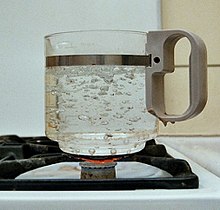
Back مادة كيميائية Arabic Sustancia químico AST Maddə Azerbaijani Хімічнае рэчыва Byelorussian Рэчыва BE-X-OLD Химично вещество Bulgarian रासायनिक पदार्थ Bihari Hemijska supstanca BS Substància química Catalan ماددەی کیمیایی CKB

A chemical substance is a unique form of matter with constant chemical composition and characteristic properties.[1][2] Chemical substances may take the form of a single element or chemical compounds. If two or more chemical substances can be combined without reacting, they may form a chemical mixture.[3] If a mixture is separated to isolate one chemical substance to a desired degree, the resulting substance is said to be chemically pure.[4]
Chemical substances can exist in several different physical states or phases (e.g. solids, liquids, gases, or plasma) without changing their chemical composition. Substances transition between these phases of matter in response to changes in temperature or pressure. Some chemical substances can be combined or converted into new substances by means of chemical reactions. Chemicals that do not possess this ability are said to be inert.
Pure water is an example of a chemical substance, with a constant composition of two hydrogen atoms bonded to a single oxygen atom (i.e. H2O). The atomic ratio of hydrogen to oxygen is always 2:1 in every molecule of water. Pure water will tend to boil near 100 °C (212 °F), an example of one of the characteristic properties that define it. Other notable chemical substances include diamond (a form of the element carbon), table salt (NaCl; an ionic compound), and refined sugar (C12H22O11; an organic compound).
- ^ Hale, Bob (2013-09-19). Necessary Beings: An Essay on Ontology, Modality, and the Relations Between Them. OUP Oxford. ISBN 9780191648342. Archived from the original on 2018-01-13.
- ^ IUPAC, Compendium of Chemical Terminology, 2nd ed. (the "Gold Book") (1997). Online corrected version: (2006–) "Chemical Substance". doi:10.1351/goldbook.C01039
- ^ "2.1: Pure Substances and Mixtures". Chemistry LibreTexts. 2017-03-15. Retrieved 2024-01-07.
- ^ Hunter, Lawrence E. (2012-01-13). The Processes of Life: An Introduction to Molecular Biology. MIT Press. ISBN 9780262299947. Archived from the original on 2018-01-13.